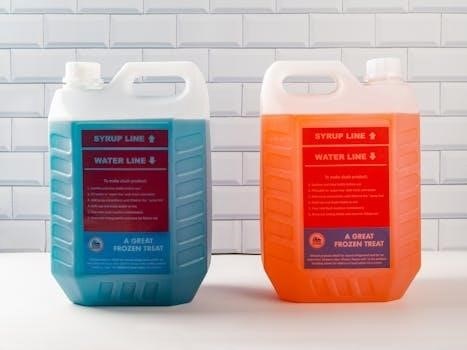Martha White Cornbread Mix Instructions⁚ A Comprehensive Guide
Martha White Cornbread Mix is a southern staple. This guide will give you the key steps to baking delicious cornbread using Martha White. From ingredient selection to perfect baking times, we ensure a golden, moist result.
Martha White Cornbread Mix has been a trusted name in kitchens for generations, offering a simple and reliable way to create classic southern cornbread. Known for its consistent quality and ease of use, this mix allows both novice and experienced bakers to achieve delicious results every time. The beauty of Martha White lies in its convenience; with just a few added ingredients, you can transform the mix into a comforting, golden-brown side dish that complements a wide range of meals.
Whether you’re pairing it with barbecue, chili, or a simple weeknight dinner, Martha White Cornbread Mix is a versatile option for any occasion. The mix contains enriched cornmeal and flour, leavening agents, and other essential components, ensuring a consistent texture and flavor. Its self-rising nature eliminates the need for additional baking powder, streamlining the baking process.
This guide will walk you through the essential steps to preparing Martha White Cornbread Mix, offering tips and variations to customize your cornbread to your liking. From mastering the basic recipe to exploring creative additions like cheese, jalapeños, or sausage, you’ll discover how to make the most of this iconic mix.
Essential Ingredients for Classic Martha White Cornbread
To embark on your cornbread journey with Martha White, gather these essential ingredients. First, the star⁚ Martha White Self-Rising Cornmeal Mix, ensuring a beautiful rise without extra fuss. Next, choose your liquid – buttermilk or milk. Buttermilk adds a tangy depth, enhancing the southern flavor, while milk keeps it light and simple. You’ll also need one large egg to bind the ingredients, contributing to the cornbread’s structure and richness.
A touch of vegetable oil, or melted shortening, is crucial for moisture and a tender crumb. Some recipes suggest a tablespoon of sugar, but you can omit it if you prefer a less sweet cornbread. For those who enjoy a savory twist, consider adding melted butter for extra richness.
Ensure all ingredients are fresh for the best results. The quality of your ingredients directly impacts the taste and texture of your cornbread. With these basics in hand, you’re ready to transform the simple mix into a warm, comforting loaf of classic Martha White cornbread. Proper ingredient preparation is key to achieving the perfect balance of flavors and textures.
Basic Instructions for Martha White Cornbread
Let’s dive into the simple steps for making Martha White cornbread. Begin by preheating your oven to 425 degrees Fahrenheit. While the oven heats, grease an 8-inch skillet or square pan. For a crispy crust, place the greased pan in the oven for 7 to 8 minutes to heat up.
In a mixing bowl, combine the Martha White cornmeal mix, one large egg, and 2/3 cup of milk. Stir until the batter is smooth, being careful not to overmix. Overmixing can lead to a tougher cornbread. If the batter appears too thick, add a tablespoon or two of additional milk until it reaches a creamy, pourable consistency.
Carefully remove the hot skillet or pan from the oven and pour the batter into it. Bake for 20 to 25 minutes, or until the cornbread is golden brown. A toothpick inserted into the center should come out clean. Once baked, let the cornbread cool slightly before cutting and serving. This basic method ensures a delicious, classic cornbread that’s perfect for any meal. Always monitor the cornbread while baking to prevent burning.
Baking Pan Options⁚ Skillet vs. Muffin Tin vs. Square Pan
When preparing Martha White cornbread, the choice of baking pan significantly impacts the final product. A skillet, particularly cast iron, is a classic choice. It heats evenly, creating a golden-brown, crispy crust. Preheating the skillet in the oven before adding the batter is key for achieving that desired texture. This method is ideal for a rustic, traditional cornbread.
For individual servings, a muffin tin is an excellent option. Fill each cup about 2/3 full to allow for rising. Muffin tin cornbread cooks faster, resulting in soft, moist muffins that are perfect for portion control or serving a crowd. Baking in a muffin tin ensures each piece has a slightly crisp edge and a tender interior.
A square pan offers a middle ground. It provides even baking and is suitable for those who prefer a softer crust. Lightly coating the pan with cooking spray helps prevent sticking. Cornbread baked in a square pan is easy to cut into uniform pieces and is a versatile option for everyday meals. Each pan offers a unique texture and presentation, allowing you to customize your Martha White cornbread to your preference.

Temperature and Baking Time Guidelines
Achieving perfectly baked Martha White cornbread hinges on following precise temperature and baking time guidelines. Generally, preheating your oven to 400°F (200°C) is recommended. This temperature ensures the cornbread rises properly and develops a golden-brown crust. However, some recipes suggest a slightly higher temperature of 425°F (220°C) for a crispier exterior.
Baking time varies depending on the pan used. For a 9-inch square pan, bake for approximately 20-25 minutes. If using a skillet, the baking time may extend to 25-30 minutes. Muffin tins require a shorter baking time, around 15-20 minutes. Keep an eye on your cornbread. It is ready when a toothpick inserted into the center comes out clean.
Over-baking can lead to dry, crumbly cornbread, while under-baking results in a mushy texture. Adjust baking times according to your oven’s performance and the specific recipe. A golden-brown color and a firm texture are key indicators of doneness. Accurate temperature and time management are crucial for mastering the art of baking Martha White cornbread.
Tips for Achieving a Golden Brown Crust
A golden-brown crust is a hallmark of perfectly baked Martha White cornbread. To achieve this desirable finish, several techniques can be employed. Firstly, ensure your oven is preheated to the correct temperature, typically around 400-425°F (200-220°C). A hot oven promotes rapid browning.
Secondly, consider using a cast iron skillet. Preheat the skillet in the oven for a few minutes before pouring in the batter. This creates a sizzling effect that encourages a crispy crust. Coating the skillet with a bit of shortening or oil also aids in browning and prevents sticking.

Another trick is to brush the top of the cornbread with melted butter or a mixture of butter and honey during the last few minutes of baking. This adds flavor and enhances the golden color. Be vigilant and watch the cornbread carefully. If it starts to brown too quickly, tent it with foil to prevent burning. Proper heat, skillet preparation, and a touch of butter are your allies in achieving that perfect golden-brown crust on your Martha White cornbread.
Troubleshooting⁚ Why Your Cornbread Crumbles
A common issue when baking Martha White cornbread is a crumbly texture. Several factors can contribute to this problem, but they are easily addressed with a few adjustments. One primary cause is overbaking. Cornbread can dry out quickly, leading to excessive crumbling. Ensure you are baking it for the recommended time and check for doneness by inserting a toothpick into the center; it should come out clean.
Another culprit could be insufficient moisture. If your batter seems too thick, try adding a tablespoon or two of additional milk or buttermilk until it reaches a creamy, pourable consistency. The type of cornmeal mix also matters. Martha White self-rising cornmeal mix already contains leavening agents, so avoid adding extra baking powder or baking soda, as this can disrupt the balance of ingredients.
Finally, be gentle when handling the cornbread after baking. Allow it to cool slightly in the pan before cutting and serving, as it will firm up as it cools. By carefully monitoring baking time, adjusting moisture levels, and handling with care, you can prevent your Martha White cornbread from crumbling.
Liquid Adjustments⁚ Milk vs. Buttermilk
The choice between milk and buttermilk in your Martha White cornbread recipe significantly impacts the final product’s taste and texture. Buttermilk, a traditional ingredient, imparts a tangy flavor and tender crumb due to its acidity, which reacts with the leavening agents in the cornmeal mix. This reaction creates a lighter, more airy cornbread.

If using milk, the cornbread will have a milder flavor and slightly denser texture. It’s important to note that if substituting milk for buttermilk, you may want to add a touch of acidity, such as a teaspoon of lemon juice or vinegar, to mimic the effect of buttermilk. This helps activate the leavening agents and ensures a better rise.
The amount of liquid may also require adjustment depending on the humidity and the specific Martha White cornmeal mix used. Start with the recommended amount and gradually add more until the batter is creamy and pourable, but not too thin. Remember, achieving the perfect consistency is key to a moist and delicious cornbread.
Creative Variations⁚ Adding Flavor and Texture
Elevate your Martha White cornbread by exploring creative variations that add exciting flavors and textures. The classic recipe serves as a blank canvas, allowing you to customize it to suit your preferences and complement any meal. Consider incorporating ingredients like shredded cheddar cheese for a savory, cheesy twist, or diced jalapeños for a touch of heat.
For a sweeter cornbread, add a tablespoon or two of sugar or honey to the batter. To enhance the texture, try mixing in some cooked bacon crumbles or crumbled sausage for a hearty, flavorful bite. You can also add vegetables like corn kernels or diced bell peppers for added moisture and nutrition.
Experiment with different herbs and spices, such as rosemary, thyme, or chili powder, to create unique flavor profiles. Remember to adjust the baking time accordingly, as added ingredients may affect the overall cooking process. With a little creativity, you can transform your Martha White cornbread into a culinary masterpiece.
Sausage Cornbread Variation
Transform your classic Martha White cornbread into a savory delight with a sausage variation. This hearty twist adds a flavorful protein boost, making it a perfect side dish for breakfast, brunch, or dinner. Start by cooking your favorite type of sausage, such as breakfast sausage or Italian sausage, until it is fully cooked and crumbled. Drain off any excess grease to prevent the cornbread from becoming too oily.
Prepare the Martha White cornbread batter according to the package instructions. Once the batter is ready, gently fold in the cooked and crumbled sausage until it is evenly distributed throughout. For an extra layer of flavor, consider adding a pinch of poultry seasoning or a dash of hot sauce to the batter.
Pour the sausage-infused batter into a greased baking pan, such as a skillet or square pan, and bake according to the recommended temperature and time. The sausage will add moisture and richness to the cornbread, resulting in a delicious and satisfying dish. Serve warm and enjoy the savory goodness of this sausage cornbread variation.
Cheese and Jalapeño Cornbread Muffins
Spice up your Martha White cornbread mix by creating flavorful cheese and jalapeño cornbread muffins. This variation adds a cheesy kick and a touch of heat to the classic cornbread recipe. Start by preparing the Martha White cornbread batter according to the package instructions. Once the batter is ready, stir in shredded cheddar cheese and diced jalapeños. The amount of jalapeños can be adjusted to your preference, depending on how spicy you want the muffins to be.
For a richer flavor, consider using a blend of cheeses, such as cheddar and Monterey Jack. Be sure to remove the seeds and membranes from the jalapeños for a milder flavor. Lightly grease a muffin tin or use muffin liners. Fill each muffin cup about two-thirds full with the cheese and jalapeño cornbread batter.
Bake the muffins according to the recommended temperature and time. The cheese will melt and create a gooey, cheesy center, while the jalapeños will add a spicy kick. Once the muffins are golden brown and a toothpick inserted into the center comes out clean, remove them from the oven and let them cool slightly before serving. Enjoy these cheesy and spicy cornbread muffins as a side dish or a snack.
Storage Instructions for Leftover Cornbread
Properly storing leftover cornbread is essential to maintain its flavor and texture. After baking your Martha White cornbread, allow it to cool completely before storing. This prevents moisture buildup, which can lead to a soggy texture. Once cooled, wrap the cornbread tightly in plastic wrap or aluminum foil. This will help to keep it from drying out.
For short-term storage, you can keep the wrapped cornbread at room temperature for up to two days. Ensure it’s stored in a cool, dry place away from direct sunlight. If you want to store the cornbread for a longer period, refrigeration is recommended. Place the wrapped cornbread in an airtight container or a resealable plastic bag and store it in the refrigerator for up to a week.
To reheat refrigerated cornbread, you can warm it in the oven at a low temperature (around 300°F) for about 10-15 minutes, or microwave it in short intervals until heated through. For longer storage, cornbread can be frozen. Wrap the cooled cornbread tightly in plastic wrap and then in aluminum foil or place it in a freezer-safe bag. Frozen cornbread can last for up to two to three months. Thaw it in the refrigerator overnight before reheating.
Serving Suggestions⁚ Pairing Cornbread with Meals
Martha White cornbread is incredibly versatile and pairs well with a variety of meals, making it a perfect addition to your dining table. For a classic Southern experience, serve it alongside hearty dishes like chili, barbecue ribs, or pulled pork. The slightly sweet and crumbly texture of the cornbread complements the rich and savory flavors of these dishes beautifully.
Cornbread is also excellent with soups and stews. A warm slice of cornbread dipped into a bowl of creamy tomato soup or a robust beef stew is a comforting and satisfying combination. Consider crumbling cornbread into your soup for added texture and flavor.
For breakfast or brunch, serve cornbread with eggs, bacon, and a drizzle of honey or maple syrup. This sweet and savory combination is a delightful way to start your day. You can also use cornbread as a base for savory toppings like avocado, salsa, and a fried egg for a unique twist.
Don’t forget about holiday meals! Cornbread is a staple at Thanksgiving and Christmas dinners, often served with turkey, ham, and a variety of side dishes. Whether you prefer it plain or with added ingredients like cheese, jalapeños, or sausage, Martha White cornbread is sure to be a crowd-pleaser.
